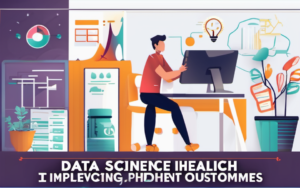Data analysis has come a long way. From its humble beginnings using rudimentary tools and painstaking manual calculations, to the sophisticated, automated, and insightful processes we see today, the evolution of data analysis is a testament to human ingenuity and technological advancement. Let’s delve into this fascinating journey.
1. The Dawn of Data Analysis
1.1 Early Methods and Tools
Early data analysis, prior to the widespread adoption of computers, relied heavily on manual methods. Think meticulously hand-drawn charts and graphs, tedious calculations using slide rules and mechanical calculators, and the painstaking process of sifting through mountains of paper records. Early data analysis techniques and tools were extremely limited, often involving simple descriptive statistics and basic visual representations of data. Analyzing even moderately sized datasets was a time-consuming and labor-intensive undertaking. The potential for error was significant, given the reliance on manual calculations and the absence of automated checks.
The sheer effort involved in data collection and analysis was a significant barrier to widespread adoption. Researchers often had to rely on readily available, pre-collected data, significantly limiting the scope of their investigations. This scarcity of data and limited analytical capabilities meant that many potentially insightful questions remained unanswered.
1.2 Limitations and Challenges
One of the biggest challenges of early data analysis compared to modern methods was the sheer scale of the task. Processing large datasets was impractical without the aid of computers. This severely limited the types of analysis that could be performed, mostly restricting researchers to simple descriptive statistics. Furthermore, the absence of sophisticated statistical software meant that many advanced techniques were simply unavailable. The time required for even basic analyses was substantial, often stretching projects out for months or even years.
Another major challenge stemmed from the limited availability of data itself. Data collection methods were less developed, and the amount of data available was drastically smaller than what we see today. This lack of data limited the scope of research and hampered the development of more powerful analytical techniques. The challenges of early data analysis were substantial, acting as a major bottleneck to progress in numerous scientific and business fields.
1.3 Key Figures and Pioneers
The early days of data analysis saw the contributions of several pioneers who laid the foundation for modern methods. John Graunt, considered a founder of demography, analyzed mortality data in 17th-century London to identify patterns and trends. Florence Nightingale, a renowned nurse, used data visualization techniques to powerfully demonstrate the impact of sanitation on mortality rates during the Crimean War, showcasing the importance of data presentation for effective communication. These individuals, along with others, demonstrated the value of data analysis in understanding complex phenomena and informing decision-making, even within the constraints of their time. Their work laid the groundwork for future advancements in the field. These early pioneers highlighted the potential of data analysis to improve decision-making, paving the way for more sophisticated applications in the years to come.
2. The Rise of Computing
2.1 The Impact of Personal Computers
The invention and widespread adoption of personal computers were revolutionary for data analysis. Suddenly, the power of computation became accessible to a far wider range of individuals and organizations. This accessibility drastically reduced the time required to perform even complex calculations, opening up new possibilities for analysis. Spreadsheets became a ubiquitous tool, providing a user-friendly interface for data manipulation and analysis. The impact of personal computers on early data analysis practices was profound, shifting the field from a niche pursuit to a more widely available and applicable tool.
The ability to store and manage large amounts of data digitally was also a critical advancement. The limitations of physical storage, such as filing cabinets overflowing with paper records, were significantly mitigated. Data could now be organized, accessed, and analyzed more efficiently.
2.2 The Development of Statistical Software
The development of statistical software packages like SPSS and SAS marked a significant turning point. These programs provided researchers with a range of powerful tools for performing complex statistical analyses, automating many of the previously manual tasks. This automation not only saved time and reduced errors but also unlocked access to more sophisticated analytical techniques, which were previously impractical or even impossible to perform manually. The evolution of data analysis methods over time is intrinsically linked to the development and refinement of this software.
These programs also made data analysis more accessible to non-specialists, democratizing the field and expanding its applications across various disciplines.
2.3 Emergence of Databases and Data Warehousing
The emergence of relational databases and data warehousing further enhanced the capabilities of data analysis. These technologies provided efficient ways to store, organize, and retrieve large volumes of data, paving the way for more comprehensive analyses. Data warehousing allowed organizations to consolidate data from various sources, providing a centralized and consistent view for analysis and reporting. This capacity to manage and analyze large and diverse datasets proved crucial in the further development of the field.
3. The Big Data Revolution
3.1 The Exponential Growth of Data
The advent of the internet and the proliferation of digital technologies led to an exponential growth in the volume of data generated. This “Big Data” revolution presented both opportunities and challenges for data analysts. The sheer scale of data necessitated new approaches and technologies to handle the volume, velocity, and variety of information. The exponential growth of data profoundly changed the landscape of data analysis, demanding new tools and techniques capable of processing massive datasets.
Handling this data required moving beyond traditional methods and adopting new technologies designed to manage and analyze data at an unprecedented scale.
3.2 New Technologies and Frameworks (Hadoop, Spark)
The challenges of handling Big Data led to the development of new technologies and frameworks such as Hadoop and Spark. These distributed computing frameworks enabled the processing of massive datasets across clusters of computers, making previously impossible analyses feasible. Hadoop provided a robust platform for storing and processing large volumes of unstructured data, while Spark offered a faster and more efficient alternative for certain types of analysis. These tools were essential for handling the immense datasets generated in the Big Data era.
These technologies opened up new avenues for data analysis and enabled researchers and businesses to extract valuable insights from previously unmanageable volumes of information.
3.3 Cloud Computing and Scalability
Cloud computing emerged as a vital component of Big Data analysis, providing scalable and cost-effective solutions for storing and processing massive datasets. Cloud platforms offered the flexibility to scale resources up or down as needed, adapting to the fluctuating demands of data analysis tasks. This scalability was critical for handling the unpredictable nature of Big Data workloads, ensuring that analyses could be performed efficiently and effectively. Cloud computing has become integral to modern data analysis, providing the infrastructure necessary to manage and process increasingly large datasets. The ability to scale resources on demand allows for greater flexibility and efficiency in data analysis projects.
4. Modern Data Analysis Techniques
4.1 Machine Learning and AI
Modern data analysis heavily leverages machine learning and artificial intelligence (AI). These techniques allow computers to learn from data without explicit programming, enabling the identification of complex patterns and predictions that would be impossible to discern manually. Machine learning algorithms are used for a wide range of tasks, including classification, regression, clustering, and anomaly detection. AI and machine learning have become indispensable tools in modern data analysis, enabling the discovery of insights previously hidden within large and complex datasets.
The applications of machine learning are vast and continue to expand across various industries and disciplines.
4.2 Data Visualization and Storytelling
Effective data visualization plays a crucial role in modern data analysis. Converting complex datasets into clear and compelling visuals enables easier understanding and communication of insights. Data visualization techniques, ranging from simple charts and graphs to interactive dashboards, are essential for conveying findings to a diverse audience, including technical and non-technical stakeholders. The ability to effectively communicate data-driven insights is a critical skill for data analysts.
The process of transforming data into a compelling narrative further enhances the impact of data analysis.
4.3 Advanced Statistical Modeling
Advanced statistical modeling techniques, such as Bayesian methods and causal inference, are increasingly used in modern data analysis. These methods allow for more sophisticated analyses, enabling deeper understanding of complex relationships within data. Bayesian methods provide a framework for incorporating prior knowledge into analyses, while causal inference focuses on establishing cause-and-effect relationships between variables. These advanced statistical techniques enhance the rigor and precision of data analysis.
5. The Future of Data Analysis
5.1 Ethical Considerations and Bias
As data analysis plays an increasingly important role in decision-making, ethical considerations are paramount. Addressing issues of bias in data and algorithms is crucial to ensure fairness and avoid discriminatory outcomes. Data analysts must be aware of potential biases and take steps to mitigate their impact. Ethical considerations are becoming increasingly important in the field of data analysis as the impact of data-driven decisions grows.
Transparency and accountability are also key aspects of ethical data analysis.
5.2 Emerging Trends and Technologies
Several emerging trends are shaping the future of data analysis. The rise of edge computing, allowing for data processing closer to the source, offers increased speed and efficiency. Quantum computing holds the potential to revolutionize data analysis by enabling the processing of extremely complex datasets. Advances in natural language processing (NLP) and computer vision are expanding the types of data that can be analyzed, including textual and image data. These emerging technologies promise to further transform the field of data analysis, offering new capabilities and opportunities.
These advancements are constantly pushing the boundaries of what’s possible in data analysis.
5.3 The Role of Data Analysts in the Future
The role of data analysts in the future is evolving. Data analysts will need to possess not only technical skills in data manipulation and analysis but also strong communication and storytelling abilities to effectively communicate insights to diverse audiences. The ability to work collaboratively with other professionals, such as business stakeholders and software engineers, will be increasingly important. The demand for skilled data analysts will continue to grow as organizations increasingly rely on data-driven decision-making. The future of data analysis is bright, driven by continuous innovation and the growing importance of data in all aspects of our lives. The ability to extract meaningful insights from increasingly complex datasets will remain a highly valuable skill.




